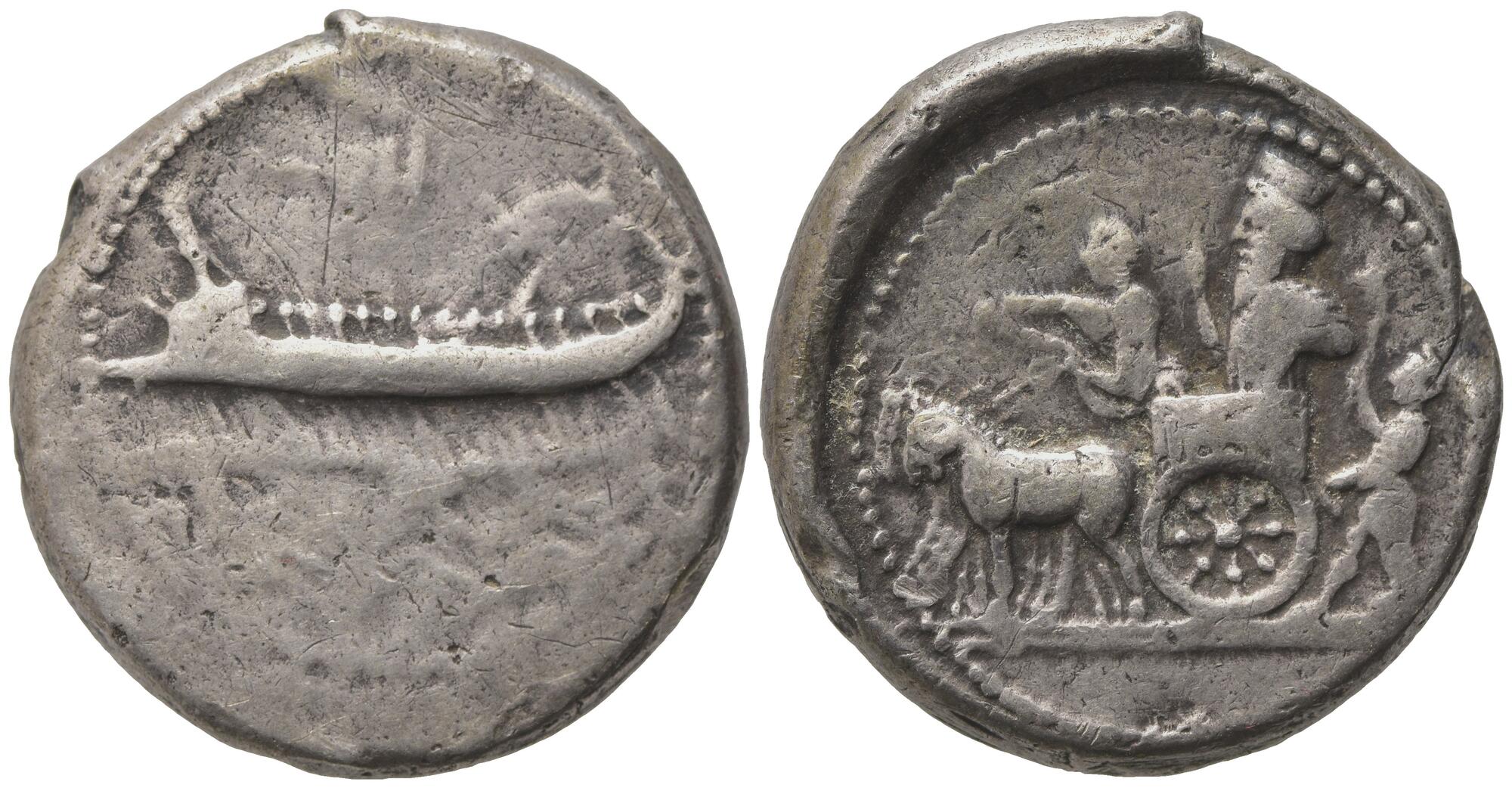Sidon (`Abd`aštart), silver, double shekels (365-352 BCE)
From SILVER
365 BCE - 352 BCE Silver 21,264 kg
Description
| ObverseInscription or printing placed on the obverse.: | Phoenician galley l., waves below |
| ReverseInscription or printing placed on the reverse.: | King of Persia and driver in chariot drawn by two horses l., behind, King of Sidon standing l., holding sceptre and vase |
Mint and issuing power
| MintIdentifies the place of manufacture or issue of a numismatic object.: | Sidon | Ancient regionAncient region.: | Phoenicia | Modern countryModern country: Lebanon | AuthorityIdentifies the issuing power. The authority can be "pretended" when the name or the portrait of X is on the coin but he/she was not the issuing power. It can also be "uncertain" when there is no mention of X on the coin but he/she was the issuing power according to the historical sources: | Persian Empire, `Abd`aštart (king of Sidon, 365-352 BCE) |
Chronology
| FromIdentifies the initial date in a range assigned in a numismatic context. | 365 BCE | toIdentifies the final date in a range assigned in a numismatic context.. | 352 BCE | PeriodTime period of the numismatic object.: Classical 480-323 BC |
Physical description
| MetalThe physical material (usually metal) from which an object is made.: | Silver |
Median weightMedian of the weights of numismatic objects (in grams). in grams | 25.70 | DenominationTerm indicating the value of a numismatic object. Examples: tetradrachm, chalkous, denarius.: | double shekel | StandardStandard.: | Persian |
Image

S1887 Sidon double shekels IV.2 (365-352).jpg [1]
References
| Die study referencePublication of the study: | Elayi - Elayi 20041Elayi - Elayi 2004, p. 181-202, n° 1235-1373 (Group IV.2.1) | ||
| Coin series referenceReference to coin series study: | Sear I2Sear I, n° 5937, HGC 103HGC 10, n° 242 | ||
| Coin series web referenceCoin series web references: | |||
Obverse dies distribution
| FrequencyFrequency of specimen in distribution. ᵖ | Number of obversesNumber of obverse dies. ᵖ (o) | % (o) | Number of coinsNumber of coins. (n) | % (n) | Die nameName(s) of the die(s). |
| 1 | 10 | 29.41 | 10 | 8.62 | 1, 2, 5, 6, 9, 16, 22, 23, 24, 27 |
| 2 | 6 | 17.65 | 12 | 10.34 | 3, 10, 12, 18, 19, 20 |
| 3 | 5 | 14.71 | 15 | 12.93 | 7, 8, 11, 15, 28 |
| 4 | 5 | 14.71 | 20 | 17.24 | 4, 13, 25, 26, 29 |
| 5 | 3 | 8.82 | 15 | 12.93 | 21, 31, 33 |
| 6 | 1 | 2.94 | 6 | 5.17 | 17 |
| 7 | 2 | 5.88 | 14 | 12.07 | 30, 32 |
| 11 | 1 | 2.94 | 11 | 9.48 | 14 |
| 13 | 1 | 2.94 | 13 | 11.21 | 34 |
| Total | 34 of 34 | 100 | 116 of 116 | 99.99 |
Reverse dies distribution
no distribution is available
Quantification
| Number of obversesNumber of obverse dies. ᵖ (o) | 34 | Number of singletons (o1)The number of singleton coins. ᵖ | 10 |
| Number of reverse diesNumber of reverse dies. (r) | 46 | Number of coinsNumber of coins. (n) | 116 |
| Coins per obverse dieNumber of coins per obverse die. (n/o) | 3.41 | Coins per reverse dieNumber of coins per reverse die. (n/r) | 2.52 |
| Reverse per obverse ratioRatio of obverse dies divided by reverse dies. (r/o) | 1.35 | Percentage of singletons (o1)number of coins (n) divided by the number of singletons (o1) ᵖ | 29.41 % |
| Original number of dies (O) (Carter 1983 formula)The estimation of the number of coins according to Carter 1983 ᵖ | 41.37 | Coins struck if 20,000 as average productivity per dieCoins made if the average productivity for obverses (according to Carter) is 20,000. ᵖ | 827,400 |
| Original number of dies (O) (Esty 2011 formula)The estimation of the number of coins according to the singleton formula in Esty 2011 ᵖ (O) | 48.1 | Survival rate if 20,000 as average productivity per dieSurvival rate if average productivity is 20,000. ᵖ | 0.00014 |
| Coverage (o = % of O) (Esty 1984 formula)Esty 1984 - coverage (% of O) ᵖ (o = % of O) | 91.38% | Die productivity if survival rate 1/2,000Average productivity if survival rate is 1/2,000. ᵖ | 5,607.93 |
| Weight of silver (in kg) if 20,000 coins per die (O = Carter formula)Carter 1983 * Median weight * 20000 (*10 if gold or electrum) ᵖ | 21,264 kg <br /> 21,264 kg | Die productivity if survival rate 1/5,000Average productivity if survival rate is 1/5,000. ᵖ | 14,019.82 |
Remarks